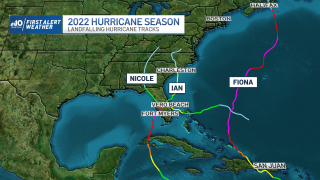
As the final day of November is upon us, the end of the 2022 Atlantic Hurricane season nears.
This season saw 14 named storms (tropical storms or hurricanes, with winds greater than 39 miles per hour). Of those, eight became hurricanes, meaning winds were greater than 74 miles per hour. Two intensified to major hurricanes (Category 3 or greater) with winds reaching or surpassing 111 miles per hour.
WATCH ANYTIME FOR FREE
Stream NBC10 Boston news for free, 24/7, wherever you are. |
Because of its size, the closest storm to New England, Fiona, wasn’t too far away. At its closest approach, the storm brought gusty winds and rough surf to coastal waters off the Islands and the Cape.
An average season yields 14 named storms, seven hurricanes and three major hurricanes. This season saw three hurricane landfalls in the U.S.:
Get updates on what's happening in Boston to your inbox. Sign up for our News Headlines newsletter.
Hurricane Fiona – Category 1 – Punta Tocon, Puerto Rico
Hurricane Ian – Category 4 – Cayo Costa, Florida
Hurricane Nicole – Category 1 – north Hutchinson Island, Florida

While the season was average, it still brought substantial damage and loss of live. Hurricane Ian tied for the fifth-strongest hurricane to ever make landfall in the U.S. Coastal communities along the barrier islands of Captiva, Sanibel, Pine & Fort Myers Beach were washed away. Downpours brought 10-20 inches of rain which led to inland flooding.
According to NOAA and the National Centers for Environmental Information, since 1980, five hurricanes have produced $20+ billion in damage in Florida—Andrew (1992), Charley (2004), Wilma (2005), Irma (2017), and Michael (2018). Hurricanes Andrew and Irma produced the highest damage totals in Florida (approximately $50 billion for each storm).
Hurricane Ian's impact is anticipated to exceed $50 billion in insured and uninsured losses.
The U.S. has been impacted by landfalling category 4 or 5 hurricanes in five of the last six years including Hurricanes Harvey, Irma, Maria, Michael, Laura, Ida, and Ian.
“The 2022 seasonal activity fell within NOAA’s predicted ranges for named storms and hurricanes in both our pre-season outlook and updated outlook,” said Matthew Rosencrans, lead hurricane forecaster at NOAA’s Climate Prediction Center. “La Niña conditions remained robust throughout the season while the West African Monsoon was only slightly above normal, which both largely aligned with conditions anticipated by the team at NOAA.”
NOAA says hurricane hunters flew more than 582 mission hours, collecting atmospheric data that better helps forecast hurricanes and further tropical research. They passed through the eye of a hurricane 65 times, deploying more than 1,700 scientific instruments.
The post-season analysis is still ongoing. It can take months for final reports and ratings to be released. One of those figures, the cost of hurricane damage, will likely be known years from now.
November 30 only marks the end of statistical activity. But it should be noted, hurricanes can and have happened outside of the statistical start and end to the year. The most recent late season hurricane to occur was Hurricane Alex, in January 2016. The storm didn’t make landfall in the US, but did reach peak winds of 75 knots, and a minimum pressure of 1003mb. In 2007, Tropical Storm Olga made landfall on Puerto Rico with 50 knot winds.
This article was written with information from NOAA.
Be prepared for your day and week ahead. Sign up for our weather newsletter.



